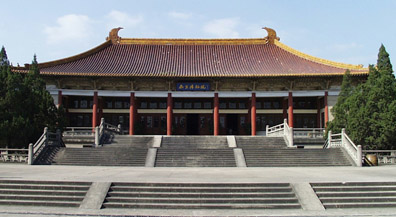 |
Just inside Zhongshan Gate, the Nanjing Museum covers an area of over 83,000 square meters. The main building, constructed in April 1933 following the architectural style of the Liao Dynasty (916-1125), is an ancient temple with yellow-glazed tiles, red-lacquered gates and columns. The Museum was moved to Yunnan and Sichuan provinces after the breakout of the Anti-Japanese War and back to Nanjing in 1946.
After the founding of the New China, the Museum was finally given the official name of the Nanjing Museum in August 1950.
More than 415,000 cultural relics, among which 718 pieces are of the first grade, are housed in the Nanjing Museum, arranged by date from the Neolithic Age to the founding of the People's Republic of China in 1949, including excavations, historical relics, revolutionary relics, folk relics, paintings, crafts, stone inscriptions, documents and foreign relics. Some of the collections are from other museums and research institutions, some are from the temporary imperial palaces in Rehe and Fengtian, some are purchased from or donated by foreign friends, and others are relics excavated mostly after the liberation.
The relics include about 2,000 rare and valuable ones. Among them, Paleolithic stone wares and colored potteries, sacred bronze wares engraved with the names of four Wu State kings of the Spring and Autumn Period (770-476BC), imperial utensils of the Warring States Period (475-221BC) engraved with 96 dragons, gold beast of 17.8cm long and 10.2cm tall, jade dress sewn with silver thread and other articles are all treasures.
Calligraphy and painting works from ancient dynasties collected by the Museum exceed 30,000, including those valuable from the Song, Yuan, Ming and Qing dynasties. There are also 2,233 folk relics representing 11 ethnic groups. In addition, the Museum contains large quantities of inscriptions of the Ming and Qing dynasties as well as precious historical documents of modern times.
The pride of the collection is the life-size Han Dynasty (206BC-221AD) jade burial suit. Unearthed in the city of Xuzhou in northern Jiangsu Province in 1970, the suit is made up of 2,600 jade pieces held together by silver wire, weighs 400 kilograms, and stretches 1.70 meters long. There is also a large wooden copy of a statue of a man with all the acupuncture points marked on his body, the original bronze version of which dates back to the Warring States Period.
The Museum consists of nine halls, seven of which have space especially for Jiangsu Historical Relics Display, exhibiting the development of Jiangsu Province from the primitive society to the modern times. The exhibition halls occupy 3,712 square meters. The other two halls hold over ten important exhibitions of painting, crafts and relics annually.
The Museum constantly organizes roadshows at home and abroad, and helps popularize historical, cultural and artistic knowledge by arranging lectures in high schools, factories or via broadcasting stations, TV and newspapers.